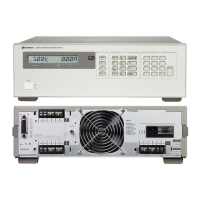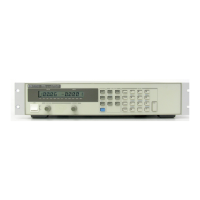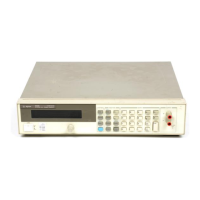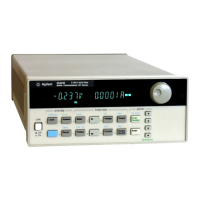Overvoltage Detector
– This circuit generates the OV DRIVE
signal which shorts the output by firing the SCR crowbar
(within the power module) on the output if any of the
following conditions are present:
1. The output at the + V terminal exceeds the
programmed OV trip point (OV PROG). Note that the
+I READBACK signal provides an offset to
compensate for the voltage drop across the current
monitor resistor. The POV DISABLE signal inhibits
the programmable OV function from affecting the OV
DRIVE signal.
2. The voltage from the + V output terminal to the +S
terminal or from the –S terminal to the –V output
terminal exceeds 10 V (applies to remote sensing
only).
3. A trip signal is received on the output’s OV terminal.
4. The output’s fixed overvoltage circuit is activated.
Power-On/Start-Up
– At power-on, the output of the turn-on
comparator circuit (BIAS TRIP input signal to U327) is
initially low which holds the PCLR and ON/OFF signals
low. With PCLR low, the microcomputer is held in the reset
off preventing any power from reaching the output
terminals.
The turn-on comparator circuit (part of U325) monitors the
unregulated bias supply to determine if it is high enough to
guarantee regulation by the three-pin regulators. The
medium rail voltage is also monitored to ensure that it is
above the minimum level required for proper operation of
the power module. When these two conditions are met, the
BIAS TRIP line is allowed to go high (approximately 0.7 V).
Then, after a delay of approximately 0.3 seconds (provided
by an external delay capacitor, C346), the PCLR signal goes
high allowing the microcomputer to complete its
initialization routine and set the OUTPUT ENABLE line
low. This allows the ON/OFF signal to go high (+ 2.4 V)
enabling the control circuit and current sources which allow
power to reach the output terminals. Note that whenever the
OUTPUT ENABLE signal is high, the ON/OFF signal is low
and turns off the control circuit thus preventing power from
reaching the output terminals.
If the line voltage drops below a minimum level, the
comparator described above will shut-down the output
(remove power from the output terminals) until normal line
voltage is restored. This resets the microcomputer and sets
the output to the turn-on state.
2-36 Bias Supplies and Precision Reference Voltage. The
bias supplies (U300-U303) generate the voltages required to
operate the circuits on the output board. The precision
reference voltage circuit (U318, U319A/B/C) operates from
the + 15 V bias and generates the VREF outputs (10 V ±
0.5%) which are used by the DAC’s and the control circuit.
2-37 Power Mesh and Control Circuits (Figure 2-5)
The power mesh circuit in the upper half of Figure 2-5
converts the AC from the power transformer to regulated
DC output power. The primary power control element is the
power module hybrid (U338). The power mesh circuit
generates a constant voltage or constant current output
under control of the control circuits shown in the lower half
of Figure 2-5. In addition to controlling the power mesh
circuit, the control circuits send measurement and status
data back to the GPIB controller and/or front panel via the
interface circuits on the output board and the GPIB board.
2-38 Rectifier and Filter. These circuits consist of two full
wave bridge rectifier circuits with filter capacitors connected
across the rectifier outputs. The proper ac voltage levels are
applied to the rectifiers via secondary windings of chassis
power transformer T1 (see Figure 2-1). The rectifiers provide
raw dc o the power module at three different levels (high,
medium, and low power rails). The return line for the
rectifier circuits is fuse protected. If this fuse opens, the
power supply will fail self test, all outputs will be disabled,
and the error message “FUSE CH <n>” will be displayed
(where n specifies the particular output board, 1-4).
2-39 Power-On Circuit and Current Sources. The power-
on circuit (Q318 and Q319) is used to turn on the current
source transistors and the bleed circuit (see paragraph 2-43)
which is connected across the output of the supply. The
power –on circuit is activated when it receives the ON/OFF
signal (2.4 V level) from the signal processor (U327).
The current sources U336) are a series of transistors
connected to the high rail. When activated by the power-on
circuit, the current sources supply a few milliamps to the +
BASE DRIVE, in conjunction with the – DRIVE signal (see
BASE DRIVE CIRCUIT description below), control the
conduction of the series pass elements and shunt ( - CL) in
the power module.
2-40 Power Module Reference Voltage. When the current
sources have been turned on, this circuit (P/O U340 and
U337) provides a reference voltage (about 2 V above + V) to
the power module REF input. The REF input is used by an
internal control circuit that allows switching between the
low, medium, and high rails. The reference circuit includes a
transistor (P/O U340) that turns on when the current
sources apply power, a programmable reference (U337)
which provides the reference voltage, and bypass capacitors
C366 and C367.
2-41 Power Module. The power module hybrid U338
receives three unregulated DC voltage levels on its high,
medium, and low voltage input rails. The power module
contains series regulator stages, an SCR overvoltage circuit,
a down programmer, a built-in overtemperature thermistor,
and a reverse output voltage protection diode.
2-10
________
____ ___
With ON/OFF low, the power control circuits are held
state.
____
_____________
_____________
___
____
Artisan Scientific - Quality Instrumentation ... Guaranteed | (888) 88-SOURCE | www.artisan-scientific.com

